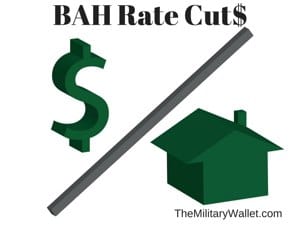Basic Allowance for Housing, or BAH, is the given to military members who are not provided with base housing. This tax-free benefit can range from a few hundred dollars per month, up to several thousand dollars per month, depending on the member’s location and whether or not they have dependents. As you can imagine, this amounts to billions of dollars paid out by the government each year. Because this is such a large line item on the Department of Defense budget each year, this has been a target for cuts, within the guidelines of the law.

As we enter 2019, BAH is now calculated to cover 95% of housing costs for the member’s rank and dependency status. Military members are expected to cover the 5% of costs, based on the DoD policies. Some members may find they have to pay more or less out of pocket, depending on where they live and the cost of their housing.
Don’t fret about this change yet. BAH Rate Protection protects your current BAH Rates. So you shouldn’t see an immediate decrease in your monthly BAH check, except under a few circumstances, which will cover in a bit. Let’s take a look at the new BAH Rate Cost-Share Policy, why it has come to be, and discuss BAH Rate Protection.
Why Cut BAH Benefits to Only Cover 95% of Housing?
It all comes down to money. The government is looking to save money anywhere it can, and the military is one of the nation’s biggest line items. Troop-related expenses, including payroll, health care, retiree benefits, and other benefits, are one of the largest line items for military spending. And since personnel costs are one of the largest military line items, they are an easy target.
This 1% cut is expected to save the government approximately $200 million per year. By the time the full cuts are made in 2019, the DoD expects to save over $1 billion per year.
Basic Allowance for Housing (BAH) impacts the majority of the military population. The 2015 defense budget called for plans to cut BAH to 95% of expected costs over the next several years. Under the current law, there will be a 1% decrease in BAH rates per year for the next five years, starting in 2015 and ending in 2019. So this is only the first step. While many servicemembers and their families will start seeing more money out of pocket in the coming years, this is still a much better situation than the 1990s, when BAH only covered 80% of expected housing costs.
BAH Rate Protection
We have a full-length article covering BAH Rate Protection, but here are the basics. Your BAH Rate is protected from the time you arrive on your installation, until you leave, with the exception of three circumstances:
- Permanent Change of Station (PCS)
- Reduction in paygrade
- Change in dependent status
In other words, your BAH rates can only increase, not decrease, unless you move to another base via a PCS, you receive a reduction in paygrade, or your dependent status changes from with dependents to without, or vice-versa. For the rest of your assignment, your BAH will be the higher of the published BAH Rate on January 1st or the BAH Rate you held on December 31 of the previous year.
I will say it again: Your BAH Rate will not drop during the middle of your assignment, even if the rates for your location decrease in any given year.
Note about a PCS moves: If you live in an area with two bases close to each other and you receive a permanent change of station assignment to the other base, you could possibly remain in the same home, but still face a decreased BAH because it would officially be a PCS move.
How Much Will This Cost Me When I Move?
At the time of this publication, the DoD hasn’t announced exactly how the cuts will take place. They could do one of several actions, including decreasing BAH 1% across the board, calculating the total cuts across the entire DoD and applying an average cut to everyone who receives BAH, or some other calculation.
Andrew Tilghman of the MilitaryTimes reported,
“Military officials do not want to create a new incentive for troops to prefer rural areas over costly urban ones, so it is likely that the Pentagon will calculate some sort of single across-the-board cut for all BAH checks.
For example, they might take the average of all 1 percent reductions nationwide and use that to determine a single dollar amount to shave from every BAH check. For example, regardless of the location and actual BAH rates, each service member may face a reduction of about $200 a year.”
Let’s look at an example: We’ll look at two different BAH rates for an E-5 with dependents. The first is the rate used for the Post-9/11 GI Bill when you take classes exclusively offered online (in-residence classes are based on the ZIP code for your school). The other BAH Rate is an E-5 in Chicago, chosen to illustrate the difference in a high cost of living location:
- E-5 with Dependents Rate (non-location, used for Post-9/11 GI Bill): $714.50, *99% = New Rate of $707.36, a difference of $7.14/month, or $85.68/year
- E-5 with Dependents Rate (Chicago): Current Rate: $1,977.00, * 99%, New Rate = $1,957.23. A difference of $19.77/month, or $237.24/year.
When put in the context of a monthly cut, $7 – $20 is noticeable, but not a massive cut. Especially if you don’t see it due to BAH Rate Protection. When you PCS to your next base, you should have a good idea of the BAH in your new area and can use that BAH when setting your budget for your new location.

Check your VA Home Loan eligibility and get personalized rates. Answer a few questions and we'll connect you with a trusted VA lender to answer any questions you have about the VA loan program.
BAH Rates Can and Do Change for Other Reasons
It’s also important to note that BAH Rates change when the cost of living in a local area changes. In general, the BAH should increase as the cost of living increases, and the BAH may decrease when the cost of living in an area decreases. Falling BAH Rates were common after the real estate markets crashed in 2007-2009. This is when BAH Rate Protection was helpful for many servicemembers.
It’s also possible that you may see increased BAH payments, even with BAH paid out at 99% of the calculated rate. The important thing to remember is that your BAH Rates should not decrease, regardless of what happens to the published rates. Your rates should only increase throughout the duration of your tour.
What Other Changes Have Been Proposed, And What is the Status?
Several other changes have been proposed since these major changes in the 2015 Defense Budget. Here are some of the proposals that were made, but did not make it into the final Defense Budgets.
Reduce BAH for Dual Military Couples (Status: Did Not Pass)
A proposal in 2015 was made to eliminate Basic Allowance for Housing (BAH) for the lower ranking member of dual military couples.
Currently, dual-military couples are both eligible to receive BAH. If the couple is married and does not have any additional dependents, they both receive the Single Member BAH rate. If they have any other dependents, then the higher ranking individual will receive the With Dependents BAH Rate and the junior ranking member will receive the Single Member BAH Rate.
This proposal would have eliminated BAH for the junior member. There were many negative reactions from military members and military lobbying organizations. The basic argument was that BAH is part of a member’s total compensation package, and eliminating BAH for some members amounted to penalizing them for being married. The proposed bill was given consideration but was not passed into law.
Reduce BAH for Military Members Who Share Housing With Other Military Members (Status: Did Not Pass)
The same proposal that would have eliminated BAH for some dual-military couples would have also reduced BAH by 25% for unmarried servicemembers who share housing with other military members.
Reducing BAH for dual-military couples and military members who cohabitate arbitrarily and effectively reduces the pay and compensation package those military members receive. It penalizes those who decide to marry another service member, and it penalizes those who decide to share living expenses with another military member.
Dual Military Members Will Both Collect Without Dependent Rates (Status: Did Not Pass)
The 2018 Defense Budget called for dual-military couples to only receive Without Dependent Rates, even if they have additional dependents. This proposal would have grandfathered in current dual-military couples.
Currently, dual-military couples are both eligible to receive BAH. If the couple is married and does not have any additional dependents, they both receive the Single Member BAH rate. If they have any other dependents, then the higher ranking individual will receive the With Dependents BAH Rate and the junior ranking member will receive the Single Member BAH Rate.
What is the Future of BAH?
Right now, we can only go from the information we have at hand, which is from the recent budget talks. The DoD has already decreased BAH rates from covering 100% of housing costs to only covering 95% of the actual cost of housing.
The DoD implemented this over a five year period, and BAH Rate Protection provisions should protect a large portion of servicemembers over the next few years. The largest impact to most servicemembers probably won’t be felt for the next couple of years.
Additionally, we have seen that continued BAH cuts are on the table. Several major proposals have been made in the interim, which would have significantly reduced military member compensation. These bills did not pass, but it is evident that housing benefits cuts are still on the table.



About the comments on this site:
These responses are not provided or commissioned by the bank advertiser. Responses have not been reviewed, approved or otherwise endorsed by the bank advertiser. It is not the bank advertiser’s responsibility to ensure all posts and/or questions are answered.